| |||||||
| Search Forums |
| Advanced Search |
| Go to Page... |
 |
| Search this Thread |  834,238 views |
| | #781 |
| BHPian Join Date: May 2009 Location: NYC / Lucknow
Posts: 703
Thanked: 4,129 Times
| Scale Models - Aircrafts & Ships In March 1996 I flew from New York to New Delhi and part of the journey was on a KLM 747. A few months later I drew this picture of the plane from memory, surprisingly at that young age I was able to some how identify the plane as a 747-400. 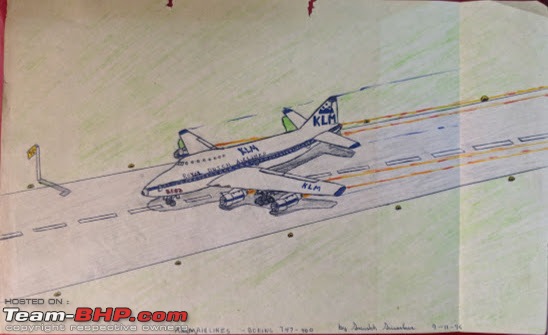 So 23 years later I managed to acquire this: 1:200 JC Wings KLM Royal Dutch Airlines Boeing 747-400 PH-BFH "95 Years Anniversary"  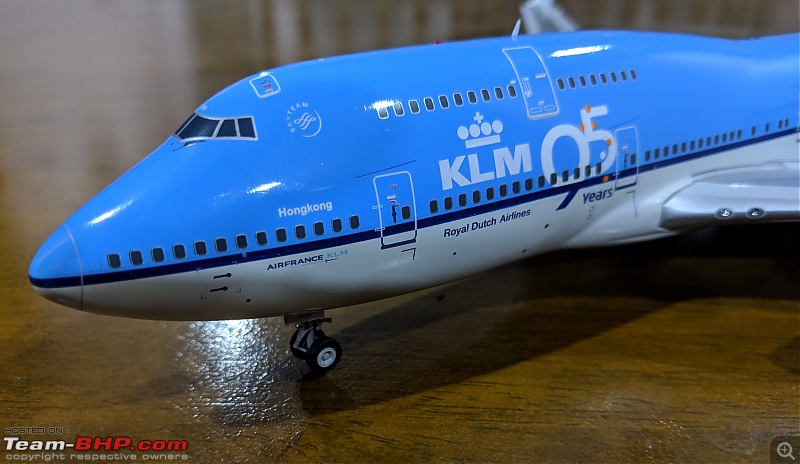   The Real Plane: 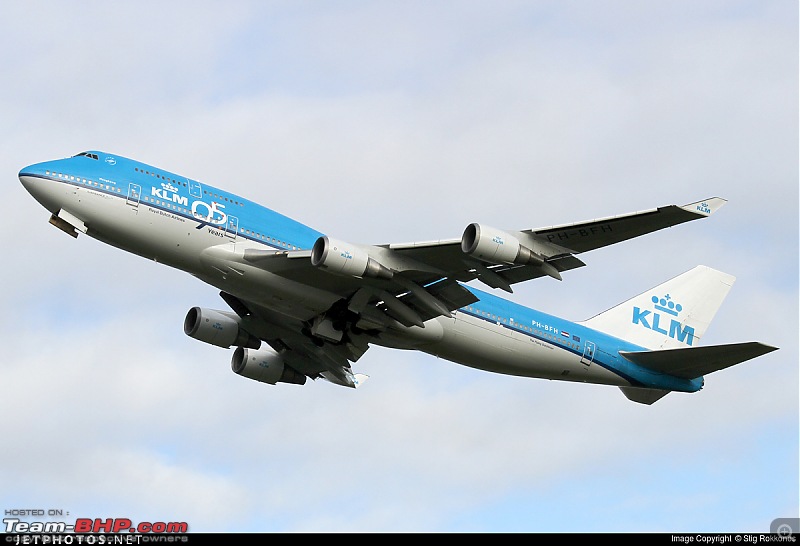 The particular plane registered PH-BFH was delivered to KLM in 1990 so it might have been the one I flew on, but I guess I will never know for sure. Next to a KLM Boeing 777-300ER.  The 1:200 Boeing 747 collection, all -400s except the Pan Am which is a -100   Just realised I have one more 1:200 747: The Lufthansa 747-8 but too lazy to take all of them out again   Last edited by Foxbat : 13th March 2019 at 19:42. |
| |  ()
Thanks ()
Thanks
|
| |
| | #782 | |
| Distinguished - BHPian  | re: Scale Models - Aircraft, Battle Tanks & Ships Quote:
KLM has a period where their livery showed a lot of white, especially on the upper part of the cabin, so your drawing could well be accurate. The PH-BFH is famous in its own way: https://thepointsguy.com/news/oldest-747-klm-retires/ | |
| |  ()
Thanks ()
Thanks
|
| | #783 |
| Distinguished - BHPian  Join Date: Aug 2014 Location: Delhi-NCR
Posts: 4,330
Thanked: 72,411 Times
| re: Scale Models - Aircraft, Battle Tanks & Ships ^^^^ Foxbat, lovely addition to your fleet and being a JC 1:200 I expect it is of a high quality of detail and finish. Your vast fleet of 747s is competing with skanchan95's squadron of Hornet F/A-18s :-) The KLM livery in my old world opinion was and is the best of all airlines - colourful, dignified and yet minimalist. In one of my units we did a lot of work for KLM, in Europe, for dozens of years. Of all the European carriers I dealt with as a lowly vendor the KLM team was by far the best and easiest to work with. I cannot say if we did work on this tail but in the spirit of things I'd say there is a 50% chance :-) Jeroen, thank you for that interesting information. Last edited by V.Narayan : 14th March 2019 at 07:55. |
| |  ()
Thanks ()
Thanks
|
| | #784 | ||
| BHPian Join Date: May 2009 Location: NYC / Lucknow
Posts: 703
Thanked: 4,129 Times
| re: Scale Models - Aircraft, Battle Tanks & Ships Quote:
https://www.flightradar24.com/data/aircraft/ph-bfh One 747 flew for 47 years before being taken out of service in 2017: https://www.theregister.co.uk/2017/0...tbed_grounded/ Quote:
| ||
| |  ()
Thanks ()
Thanks
|
| | #785 |
| Distinguished - BHPian  Join Date: Aug 2014 Location: Delhi-NCR
Posts: 4,330
Thanked: 72,411 Times
| re: Scale Models - Aircraft, Battle Tanks & Ships |
| |  ()
Thanks ()
Thanks
|
| | #786 |
| BHPian Join Date: May 2009 Location: NYC / Lucknow
Posts: 703
Thanked: 4,129 Times
| Scale Models - Aircrafts & Ships 1:200 Diecast China Airlines McDonnell Douglas MD-11 "B-151"   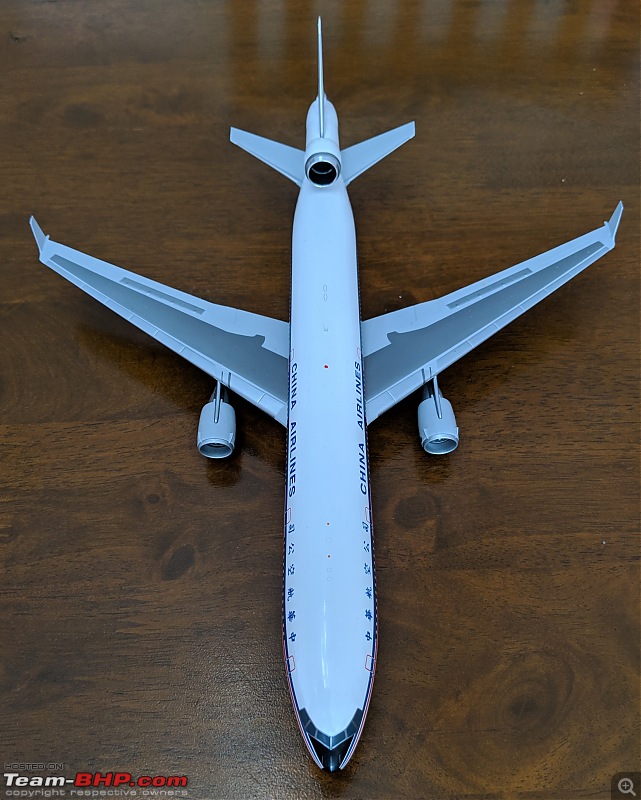  The Real B-151. 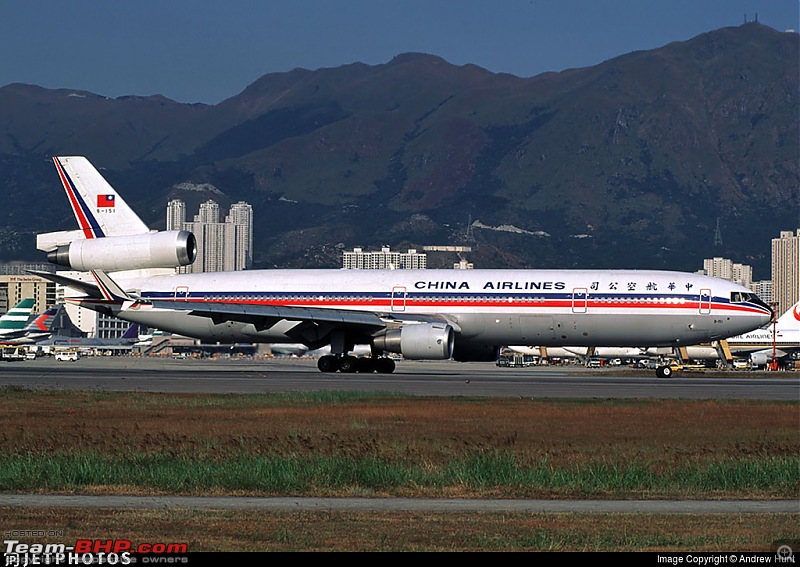 The China Airlines collection: MD-11, Constellation and Caravelle.   As the above planes have already been discussed, a bit about the airline: China Airlines (CAL) (Chinese: 中華航空; pinyin: Zhōnghuá Hángkōng) is the national carrier of Taiwan and its largest airline. It is headquartered in Taiwan Taoyuan International Airport and operates over 1400 flights weekly (including 91 pure cargo flights) to 102 cities across Asia, Europe, North America and Oceania.[4][5][6] Carrying over 19 million passengers and 5700 tons of cargo in 2017, the carrier was the 33rd and 10th largest airline in the world in terms of passenger revenue per kilometer (RPK) and freight RPK, respectively. |
| |  ()
Thanks ()
Thanks
|
| | #787 | |
| Senior - BHPian | re: Scale Models - Aircraft, Battle Tanks & Ships Quote:
1:72 Sea Harrier FRS.1 XZ451 Royal Navy 801 Squadron, HMS Hermes, Falklands War, 1982 (Corgi) The Second Royal Navy Sea Harrier in my collection. The model can be set up "in flight" mode or "in ground" mode and has separate landing gear and doors attachments for both configurations. The nozzles swivel just like the real aircraft. This particular Sea Harrier is special, not only because it is more detailed, but also because it (XZ451) was the mount of Cdr Nigel "Sharkey" Ward when he shot down an Argentine IA-58A Pucara and a C-130 during the Falklands conflict. Known by its pilots as "SHAR," more than 36 years ago the Bae Sea Harrier embarked on its first combat mission. It was April 5, 1982 when two UK's "through-deck cruisers" (aircraft carriers) leave Portsmouth for their involvement in the Falklands conflict. On board were 20 BAe Sea Harriers, only in service since 2 years. The British "Jump Jets" were heading to their baptism of fire, vastly outnumbered by proven supersonic weapons systems such as the Mirage III and the Mirage V Dagger, and no one really knew how it would perform against a real world shooting opponent; the Royal Navy's Harriers had been up against F-5Es, F-4s and F-15s in Dissimilar Air Combat Training and more than held its own. But real combat was a different matter. The SHAR was a truly multi role aircraft that it could perform air-to-air combat and ground attack and reconnaissance. The Royal Navy's SHARs went on to score 20 kills (none of which was achieved using the famous trick of stopping the plane midair by pointing the jet nozzles slightly forward inducing a 2g deceleration) to no loss in air-to-air combat. However, two were lost to ground fire (radar guided 30mm AA and a Roland missile) and a further two were lost to accidents during the conflict. The kill-to-loss ratio does not reflect the skill and braveness of the Argentinean pilots who had to face a truly astonishing fighter, which had remarkable slow flight characteristics, even without the thrust vectoring, and a superior radar.        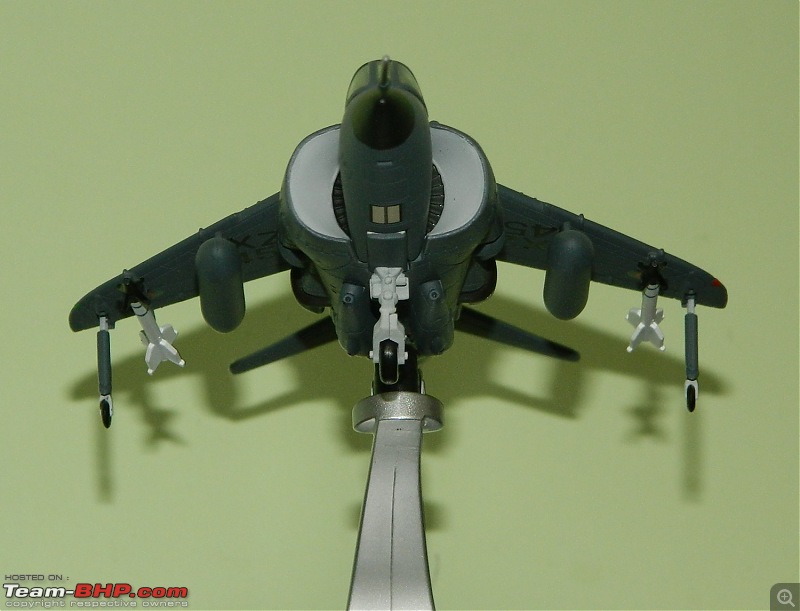  With the Amercom 1:72 Sea Harrier, which is clearly not as detailed or a heavy as the Corgi Sea Harrier  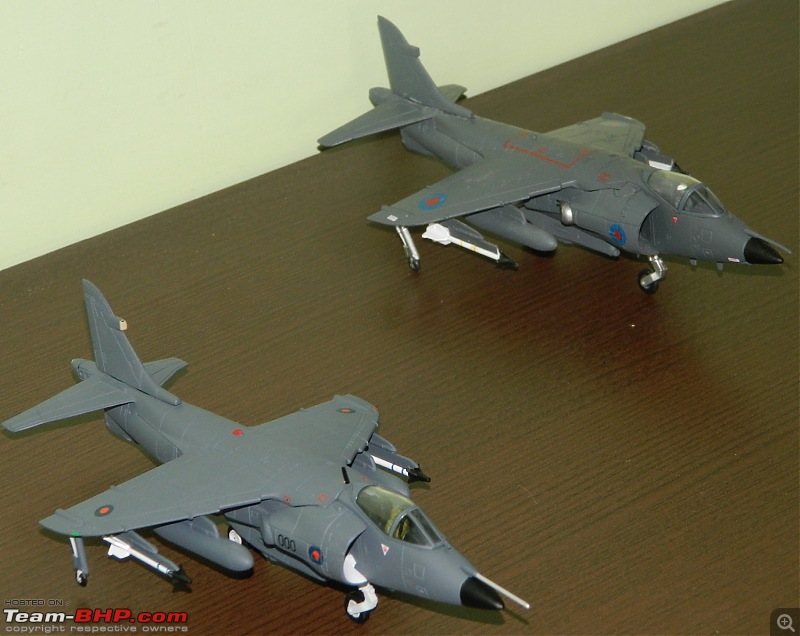  With my copy of the book written by Cdr "Sharkey" Ward - an excellent book in which the author spares no detail - he tells all about what happened during the conflict, the maneuvers, cannon fire, missiles, ejections, the politics, inter squadron rivalries/disagreements - all of it.    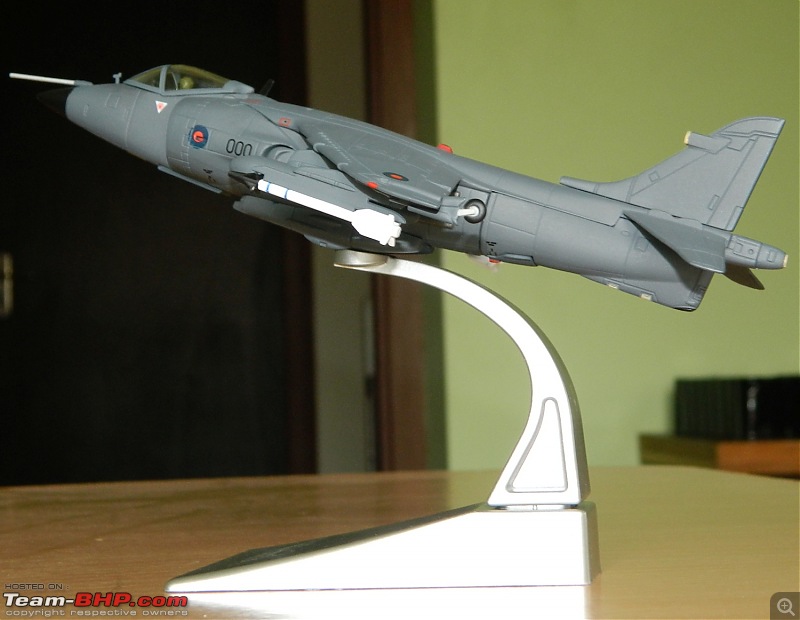 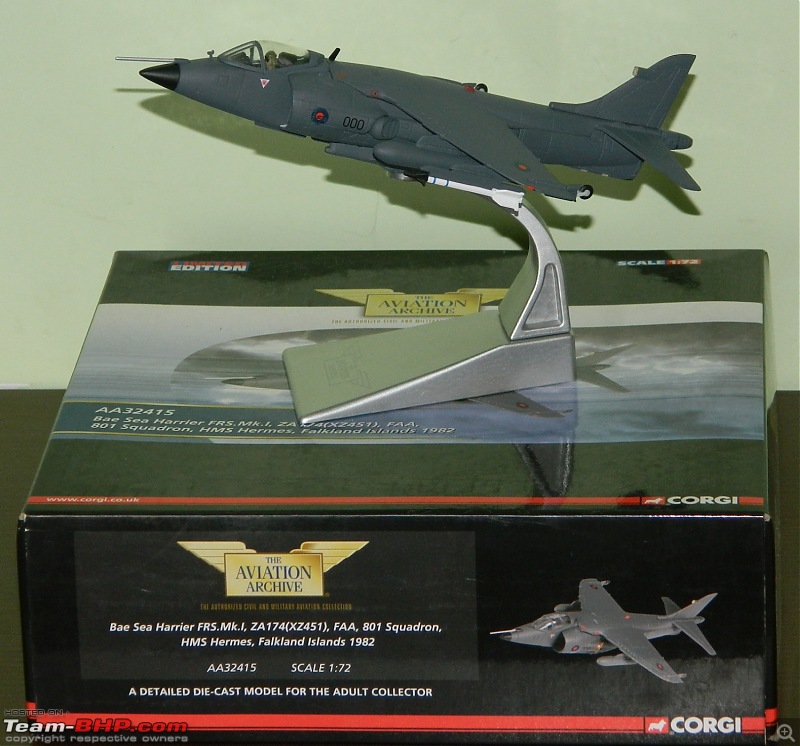 Proud owner of 25th of the 420 pieces ever made  Cdr Nigel "Sharkey" Ward 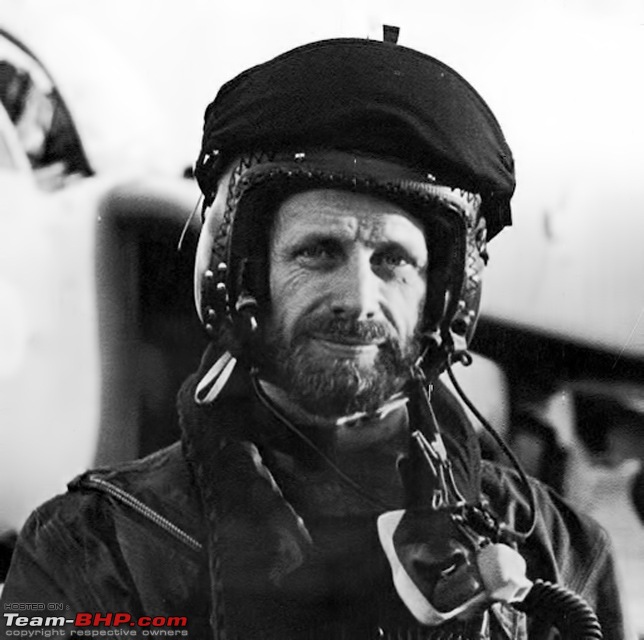 Commander Nigel David "Sharkey" Ward, DSC, AFC is a former Royal Navy Fleet Air Arm Sea Harrier pilot who commanded 801 Naval Air Squadron during the 1982 Falklands War. He shot down three Argentine aircraft during the conflict 21 May 1982 Ward, flying Sea Harrier XZ451, was one of three aircraft launched to carry out a combat air patrol at the northern end of the Falkland Sound. Two Argentine Air Force Pucaras operating from Goose Green were seen by controllers on HMS Brilliant and the three Sea Harriers were vectored towards them. One of the Pucaras was attacked by the first two Sea Harriers but evaded, and Ward made a passing cannon attack on Major Carlos Tomba's aircraft and damaged the port aileron. After slowing down and turning behind the Pucara, Ward hit the starboard engine, and in a third run he hit the canopy and upper fuselage. Tomba ejected from the Pucara at low-level before the aircraft crashed north-west of Drone Hill, Tomba was unhurt and walked back to Goose Green. Later the same day Ward, in Sea Harrier ZA175, and another aircraft were carrying out a low-level combat air patrol. Three Argentine Air Force Mirage V "Dagger"s had attacked Brilliant and the two Sea Harriers were vectored to intercept them. In a turning fight, the three Daggers were destroyed with Ward's wingman, Lieutenant Steve Thomas, accounting for two and Ward for one, all with Sidewinder missiles. The three Dagger pilots, Major Piuma, Captain Donadille and Lieutenant Senn, ejected safely. 1 June 1982 Ward, in Sea Harrier XZ451, and another aircraft were just returning to Invincible after a combat air patrol when they were sent to check a target seen on radar 20 miles north of the ship. They found a four-engined Lockheed C-130 Hercules at 200 feet above the sea. Ward's first AIM-9L Sidewinder missile fell short of the C-130, but the second started a fire between the inner and outer port engines. Ward then fired 240 rounds from his Harrier's two ADEN cannons and this action broke off the wing of the enemy aircraft, sending it crashing into the sea and killing the seven crew members. Ward flew over sixty war missions, achieved three air-to-air kills, and took part in or witnessed a total of ten kills; he was also the leading night pilot, and was decorated with the Distinguished Service Cross for gallantry. After retirement from the Royal Navy in 1989, Ward wrote the book Sea Harrier Over the Falklands: A Maverick at War, first published in 1992. In 2001, he returned to the RNAS Yeovilton to fly with his son Kris, after the younger Ward qualified to fly the Sea Harrier FA2. In 2011, while residing in Grenada, he had a friendly but emotional radio interview with Ezequiel Martel,an Argentine Air Force officer and son of Capt. Rubén Martel - the C-130 Hercules pilot shot down by Ward during the conflict. Interview with Ezequiel Martel Ward flew over sixty war missions, achieved three air-to-air kills, and took part in or witnessed a total of ten kills; he was also the leading night pilot, and was decorated with the Distinguished Service Cross for gallantry. Sea Harrier XZ451(During the war, Sea Harriers had most of their Markings removed except the roundels and underwing serial numbers).  Last edited by skanchan95 : 16th March 2019 at 12:51. | |
| |  ()
Thanks ()
Thanks
|
| | #788 | ||
| BHPian Join Date: May 2009 Location: NYC / Lucknow
Posts: 703
Thanked: 4,129 Times
| re: Scale Models - Aircraft, Battle Tanks & Ships Quote:
Quote:
2 destroyers 2 frigates 1 Landing Ship Logistics 1 Landing Craft Utility 1 container ship | ||
| |  ()
Thanks ()
Thanks
|
| | #789 | |
| Distinguished - BHPian  Join Date: Aug 2014 Location: Delhi-NCR
Posts: 4,330
Thanked: 72,411 Times
| re: Scale Models - Aircraft, Battle Tanks & Ships Quote:
A fleet based on China airlines is a rarity. Congratulations. The MD-11 deserved more success but the advent of ETOPS and more economical twin engine configurations killed it. Factoid - MD-11 was first known as the Dc-10 Super 60 and was seriously looked at in a twin engine configuration that could have competed against the Boeing 777. Your trio looks great. Interesting to view the wing planform of the three generations. | |
| |  ()
Thanks ()
Thanks
|
| | #790 |
| BHPian Join Date: May 2009 Location: NYC / Lucknow
Posts: 703
Thanked: 4,129 Times
| Scale Models - Aircrafts & Ships 1:200 JC Wings Etihad Boeing 777-300ER A6-ETQ In my opinion this is one of the best liveries on any airliner and definitely on a 777. Unfortunately Etihad have recently changed their livery.  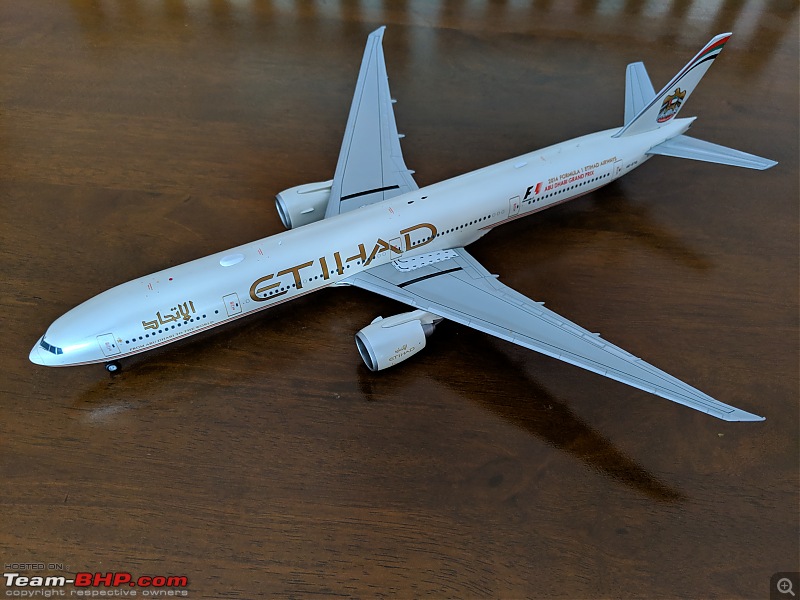 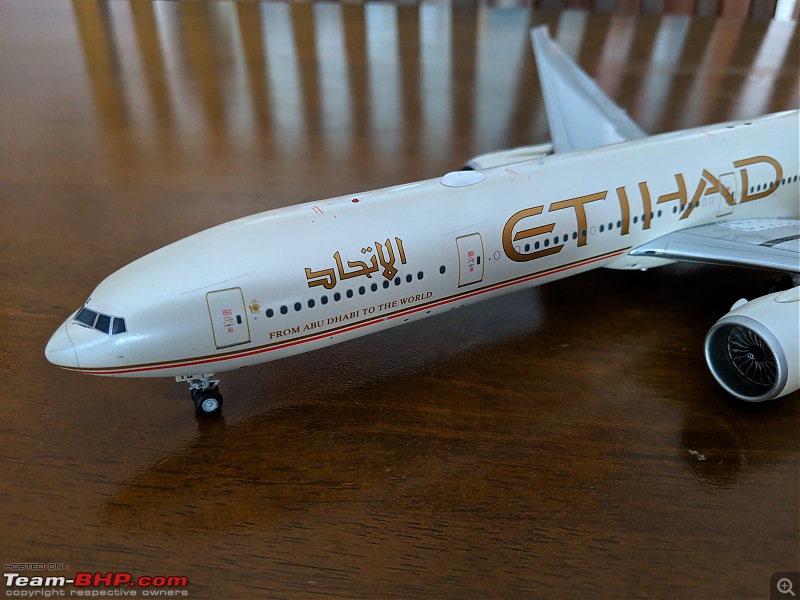  With its Dubai based rival, the Emirates 777-300ER does not have a Wi-Fi radome on top of the fuselage. 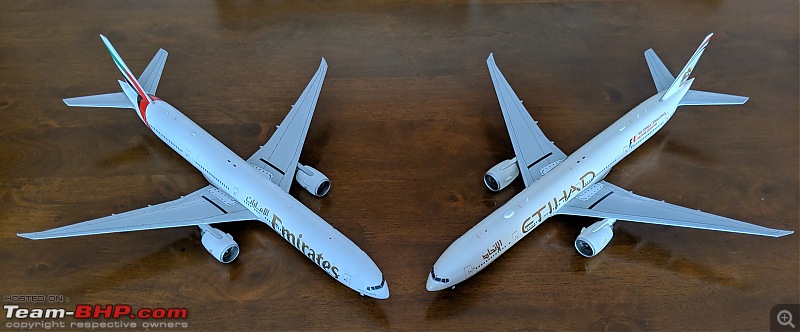 The Boeing 1:200 777-300ER collection.   I have had several pleasant journeys on Etihad and this one was one reasons for picking up this model. Here is a similar plane but with a different registration photographed by me from the upper deck of a Etihad A380 in Abu Dhabi.  |
| |  ()
Thanks ()
Thanks
|
| | #791 | ||
| Distinguished - BHPian  Join Date: Aug 2014 Location: Delhi-NCR
Posts: 4,330
Thanked: 72,411 Times
| re: Scale Models - Aircraft, Battle Tanks & Ships Beluga Airbus A300-600ST; 1:200 scale, plastic model Length: 11 inches. Wing span: 9 inches. Not a detailed model The Airbus A300-600ST (Super Transporter) or Beluga, is a version of the standard A300-600 wide-body airliner modified to carry large aircraft parts and other oversized cargo. It received the official name of Super Transporter however, the nick name Beluga, a whale it resembles, gained popularity and has since been officially adopted. Prior to the Beluga Airbus was using the Boeing’s prop driven Super Guppy transporters (see photo below). The wings, engines, landing gear, and the lower part of the fuselage remain identical to those used on the conventional A300, while the upper part of the fuselage forms an enormous horseshoe-shaped structure 7.7 m (25 ft) in diameter. In comparison with the Super Guppy, the payload was more than doubled and the volume increased by more than 30 per cent. The tail fins used are a modified Airbus A340 fin while the tail plane was strengthened and fitted with auxiliary fins to maintain directional stability in light of the bulbous fuselage. Five Belugas were made through this conversion process. Each airframe reportedly took roughly three years to complete. Over time, the Beluga has been used to carry a variety of special loads, including space station components, large and delicate artwork, industrial machinery and intact helicopters. The A300-600ST's freight compartment is 7.4 m (24 ft) in diameter and 37.7 m (124 ft) long and carries a maximum payload of 47 tonnes. To provide access to the cargo area from the front without having to disconnect all electrical, hydraulic and flight control connections (and also avoiding the lengthy recalibrations before each flight that reconnection entailed), the standard A300 cockpit was re-built relocated below the cargo-floor level. The main deck cargo volume of the Beluga is greater than that of the C-5 Galaxy or the Antonov An-124 but still smaller than Antonov An-225. However, it is restricted by cargo-weight capacity of 47 tonnes, compared to 122.5 tonnes for the C-5 Galaxy and 150 tonnes for the An-124. Length: 184 feet Wingspan: 147 feet Height: 56 feet Cargo hold – volume 1,500 cubic metres Max. takeoff weight: 155 tonnes Powerplant: 2 × General Electric CF6 turbofans, 25.7 kN each Never exceed speed: Mach 0.70, 404 knots Range: 2,700 km with 40-tonne payload Video of the new Beluga XL's maiden flight in July 2018. The XL is based on the A330 and will replace the current Beluga. Quote:
What is undisputed is the courage of pilots on both sides. In fact the Argentine pilots were the best performing part of their Armed forces. The A-4s were not modernized and used iron bombs and yet sank 2 Royal Navy warships and seriously damaged 4 more. Of the 48 A-4s deployed 22 were lost in these attacks reflecting the strength of defensive fire they faced. To keep flying when almost half your force has been shot down demands some serious spine. Quote:
 | ||
| |  ()
Thanks ()
Thanks
|
| |
| | #792 | |
| Senior - BHPian | re: Scale Models - Aircraft, Battle Tanks & Ships Quote:
The only Argentine SuE i know of was made by Altaya in 1:72 scale. Try looking on ebay. I for one would love to get my hands on an Argentine Navy A-4Q - the ones that flew a white paint scheme, had the Argentine flag painted on their rudder and who were involved in some successful attacks on British ships. | |
| |  ()
Thanks ()
Thanks
|
| | #793 | |
| BHPian Join Date: May 2009 Location: NYC / Lucknow
Posts: 703
Thanked: 4,129 Times
| re: Scale Models - Aircraft, Battle Tanks & Ships
Another unique one in your collection. Is it an official Airbus model ? Which brand ? Quote:
 Still looks good apart from the missing canopy (still can't find it). I had used white out correction fluid instead of white paint and that has really deteriorated over time. Still looks good apart from the missing canopy (still can't find it). I had used white out correction fluid instead of white paint and that has really deteriorated over time. Found this interesting article how Argentina is buying more ex-French Etendards: The Fighter Plane That Terrorized Great Britain During the Falklands War Is Back https://nationalinterest.org/blog/th...ring-the-20762 The British were so afraid of the Exocet and Etendard combination that they were ready to go to great lengths to prevent or from being deployed: "After this incident, the Thatcher government was ready to take drastic measures to deal with the Exocet threat. This led to their conceiving Operation Mikado, which envisioned using two C-130 Hercules transports to land fifty-five operators of SAS B squadron onto the Rio Grande airbase to kill the Étendard pilots and destroy their planes, before fleeing to Chile for asylum. However, on May 18, a helicopter on a scouting run for the raid crash-landed in Chile at night and its crew was captured. The UK scratched the obviously suicidal mission at the last minute. In a separate endeavor, British intelligence agents posed as Exocet arms dealers in an effort to sabotage Argentine attempts to acquire more of the missiles." Last edited by Foxbat : 19th March 2019 at 19:49. | |
| |  ()
Thanks ()
Thanks
|
| | #794 |
| Senior - BHPian | re: Scale Models - Aircraft, Battle Tanks & Ships Just realised that the canopy of my JC Wings 1:72 IAF Su-30MK can be opened with a bit of effort and good amount of care and this mechanism is the way it has been designed to work. Initially I thought the canopy was stuck and did not want to risk breaking it in an attempt to pry open the canopy. The other 1/72 JCW/WW models in my collection like the F/A-18s and EF2000 canopy open and close smoothly without much effort. So it was time for a photoshoot... 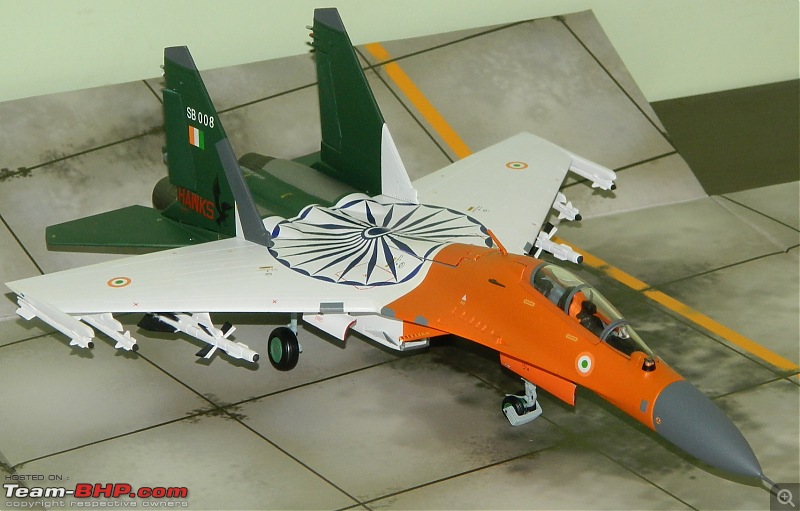   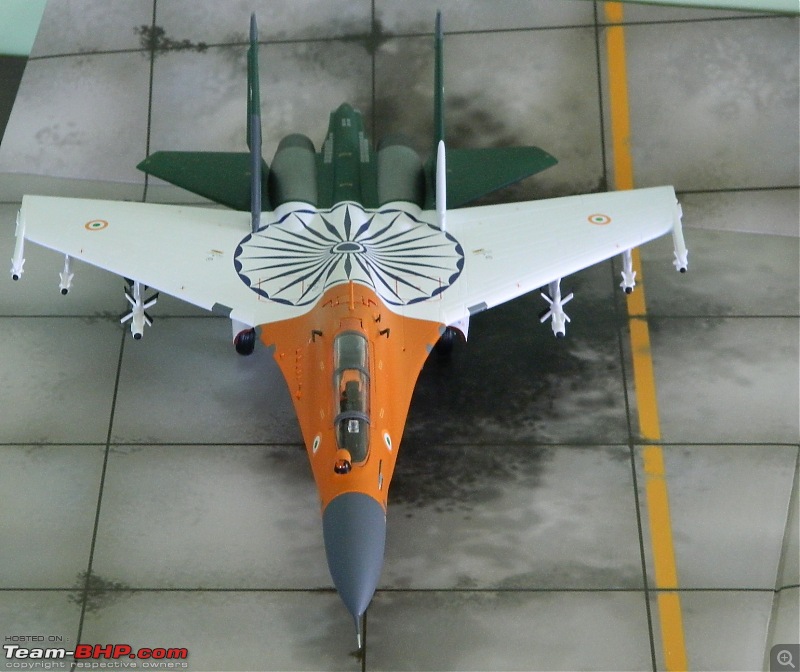  The pilot and the WSO are too big to fit in the cockpit. The only way I could use them was to make it look as if they are climbing up/down from the cockpit. 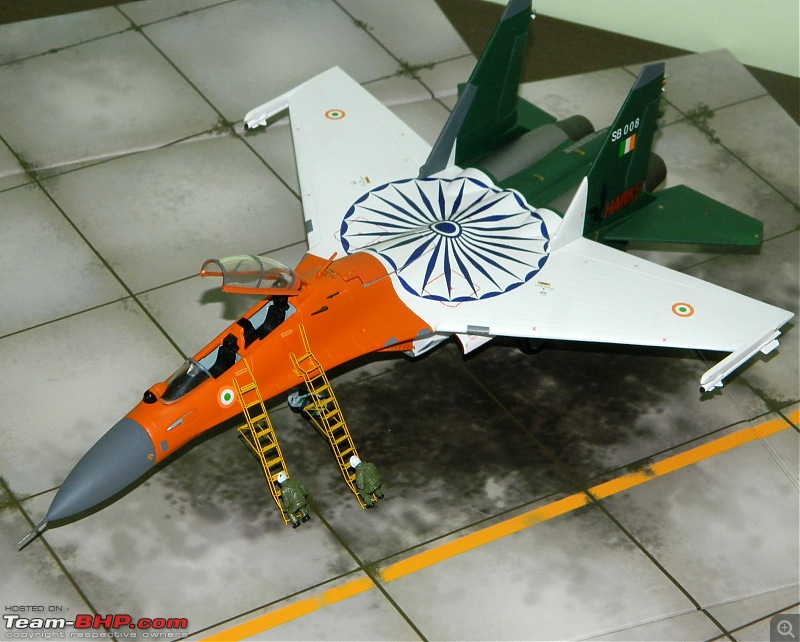  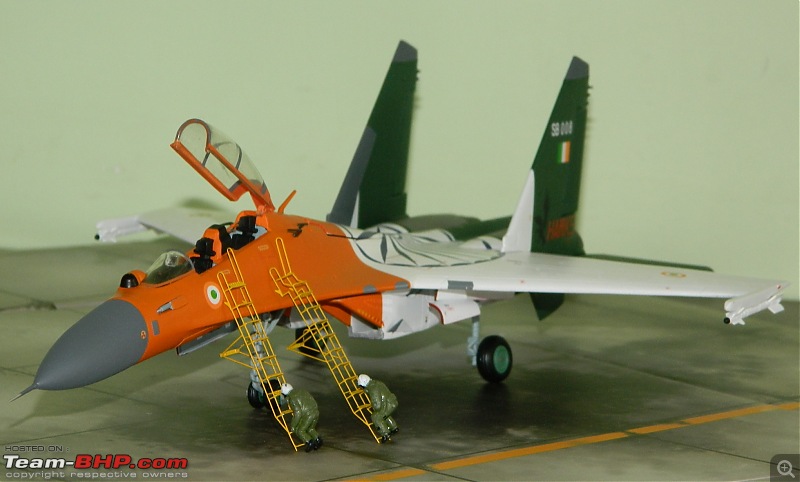   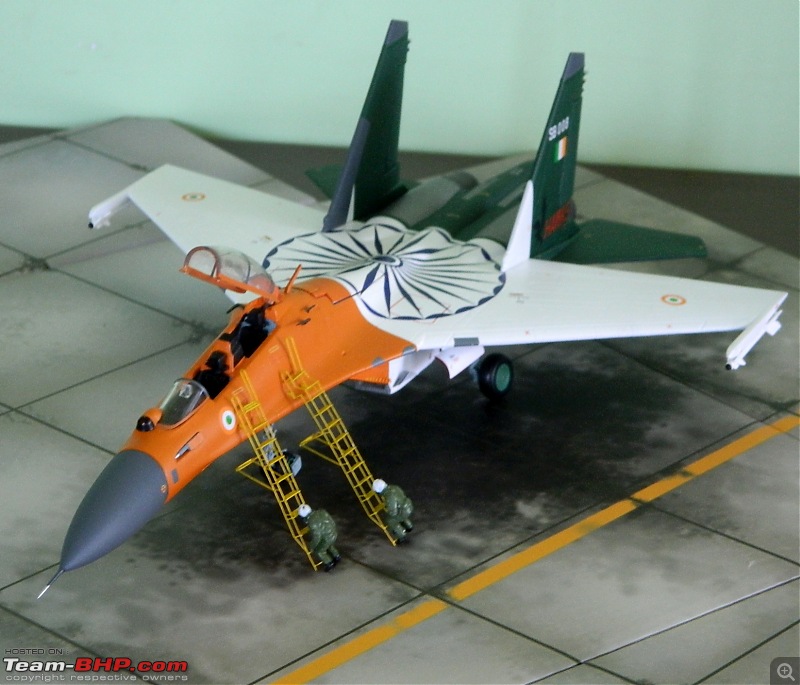  |
| |  ()
Thanks ()
Thanks
|
| | #795 | |
| BHPian Join Date: May 2009 Location: NYC / Lucknow
Posts: 703
Thanked: 4,129 Times
| re: Scale Models - Aircraft, Battle Tanks & Ships Quote:
 Are the pilots made of plastic? If so get some sandpaper and gently sand away the areas which prevent them from fitting in the cockpit. That area might lose its colour so you may have to touch it up with some paint. In my many years of experience of building fighter aircraft model this was a common problem and it was solved by making the pilots a bit smaller. | |
| |  ()
Thanks ()
Thanks
|
 |


